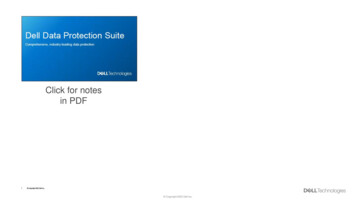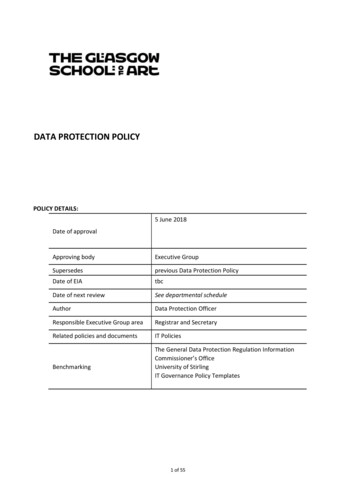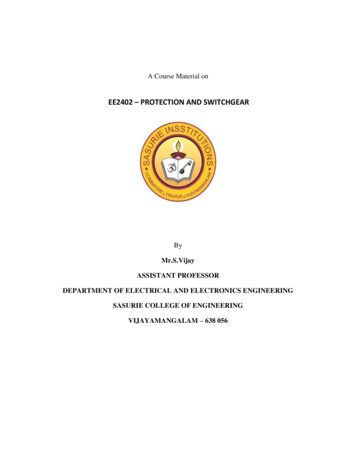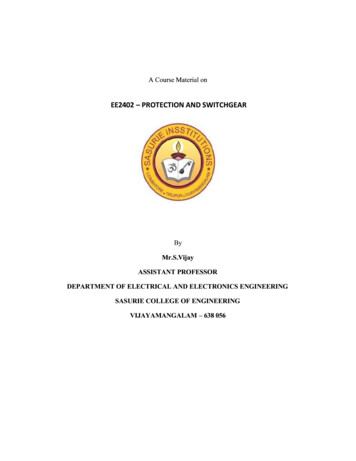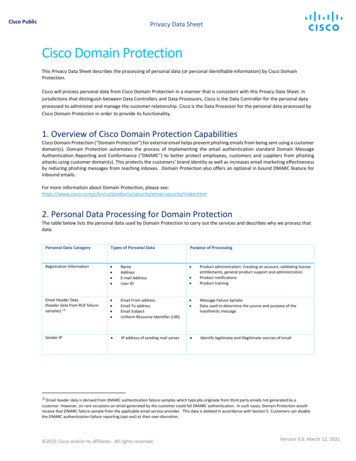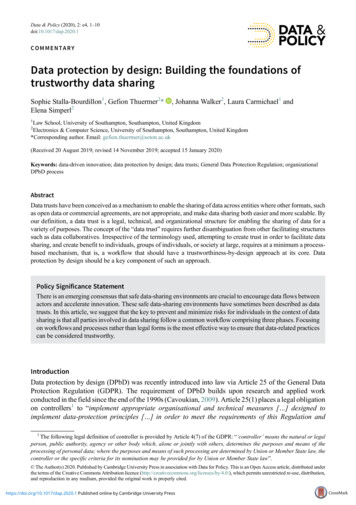
Transcription
Data & Policy (2020), 2: e4, 1–10doi:10.1017/dap.2020.1COMMENTARYData protection by design: Building the foundations oftrustworthy data sharingSophie Stalla-Bourdillon1, Gefion Thuermer2*Elena Simperl2, Johanna Walker2, Laura Carmichael1 and1Law School, University of Southampton, Southampton, United KingdomElectronics & Computer Science, University of Southampton, Southampton, United Kingdom*Corresponding author. Email: gefion.thuermer@soton.ac.uk2(Received 20 August 2019; revised 14 November 2019; accepted 15 January 2020)Keywords: data-driven innovation; data protection by design; data trusts; General Data Protection Regulation; organizationalDPbD processAbstractData trusts have been conceived as a mechanism to enable the sharing of data across entities where other formats, suchas open data or commercial agreements, are not appropriate, and make data sharing both easier and more scalable. Byour definition, a data trust is a legal, technical, and organizational structure for enabling the sharing of data for avariety of purposes. The concept of the “data trust” requires further disambiguation from other facilitating structuressuch as data collaboratives. Irrespective of the terminology used, attempting to create trust in order to facilitate datasharing, and create benefit to individuals, groups of individuals, or society at large, requires at a minimum a processbased mechanism, that is, a workflow that should have a trustworthiness-by-design approach at its core. Dataprotection by design should be a key component of such an approach.Policy Significance StatementThere is an emerging consensus that safe data-sharing environments are crucial to encourage data flows betweenactors and accelerate innovation. These safe data-sharing environments have sometimes been described as datatrusts. In this article, we suggest that the key to prevent and minimize risks for individuals in the context of datasharing is that all parties involved in data sharing follow a common workflow comprising three phases. Focusingon workflows and processes rather than legal forms is the most effective way to ensure that data-related practicescan be considered trustworthy.IntroductionData protection by design (DPbD) was recently introduced into law via Article 25 of the General DataProtection Regulation (GDPR). The requirement of DPbD builds upon research and applied workconducted in the field since the end of the 1990s (Cavoukian, 2009). Article 25(1) places a legal obligationon controllers1 to “implement appropriate organisational and technical measures [ ] designed toimplement data-protection principles [ ] in order to meet the requirements of this Regulation and1The following legal definition of controller is provided by Article 4(7) of the GDPR: “‘controller’ means the natural or legalperson, public authority, agency or other body which, alone or jointly with others, determines the purposes and means of theprocessing of personal data; where the purposes and means of such processing are determined by Union or Member State law, thecontroller or the specific criteria for its nomination may be provided for by Union or Member State law”. The Author(s) 2020. Published by Cambridge University Press in association with Data for Policy. This is an Open Access article, distributed underthe terms of the Creative Commons Attribution licence (http://creativecommons.org/licenses/by/4.0/), which permits unrestricted re-use, distribution,and reproduction in any medium, provided the original work is properly cited.https://doi.org/10.1017/dap.2020.1 Published online by Cambridge University Press
e4-2Sophie Stalla-Bourdillon et al.protect the rights of data subjects.” DPbD therefore plays a key role in enabling and demonstratingcompliance with the GDPR.In this article, we address the question of how the requirements of DPbD should shape the developmentof data trusts (this concept is explored in more detail below). We will argue that both technical andorganizational requirements are foundational to ensuring trustworthy data sharing. We further insist on thenecessity of starting with organizational measures and creating a DPbD process, which are prerequisites tothe selection of appropriate technical measures.In order to strengthen our claim, we also draw on our experience as interdisciplinary members of DataPitch2—an open innovation program—to inform our proposed approach. Data Pitch aims to bringtogether data providers (i.e., corporate and public sector organizations) to share data with successfulprogram applicants (i.e., startups and small and medium enterprises [SMEs]) to reuse for innovationpurposes. The project launched in January 2017 and will end in December 2019. It is funded by theEuropean Union’s Horizon 2020 Research and Innovation Programme.3Data TrustsData trusts have been conceived as a mechanism to enable the sharing of data across entities where otherformats, such as open data or commercial agreements, are not appropriate and make data sharing easier,more scalable (Hall and Pesenti, 2017), and mutually beneficial for members (Lawrence, 2016). Althoughthe form and purposes of data trusts are currently a topic of much discussion (e.g., Alsaad et al., 2019;Hardinges, 2018; O’Hara, 2019; Wylie and McDonald, 2018), a broadly accepted definition has not yetemerged. This is in part because data trusts may be of benefit in data-driven innovation, as well as manyother situations such as personal or health data management (Lawrence, 2016) and security, safety, andefficiency, like in the Internet of Food Things project.4 The concept of the “data trust” requires furtherdisambiguation from other facilitating structures such as data collaboratives (Susha et al., 2017).Furthermore, the use of data trusts as an internal data-sharing methodology, as it is established by firmssuch as Truata,5 has created further ambivalence around the term.By our definition, a data trust is a legal, technical, and organizational structure for enabling the sharingof data (Walker et al., 2019); they can assist with the exchange of data for a variety of purposes, one ofwhich is to help solve business or societal problems. In that, they differ from data collaboratives, whichhave the distinct goal to solve societal problems through collaboration between organizations fromdiverse sectors (Verhulst et al., 2015). For data trusts, as well as related structures such as datacollaboratives, the design, development, and utilization of robust mechanisms for responsible datasharing are crucial to engender trust and ultimately drive forward data-driven innovation and achievetheir organizational goals, regardless whether these are social or economic.The need for increased data sharingData-driven innovation is regarded as a new “growth area” for the global economy (Organisation forEconomic Co-operation and Development [OECD], 2015). Given data-driven innovation is contingentupon “the use of data and analytics to improve or foster new products, processes, organisational methodsand markets” (OECD, 2015), it is vital that interested parties have lawful access and rights to (re)use vastamounts of robust data where necessary and appropriate. It is therefore unsurprising that a key obstacle tothe growth of data-driven innovation is a lack of data sharing (Mehonic, 2018; Skelton, 2018)—also2https://datapitch.eu/For more information about Data Pitch, visit the project website at https://datapitch.eu/ (last accessed on May 10, 2019).4For more information about the Internet of Food Things project, see https://www.foodchain.ac.uk/ (last accessed on May10, 2019).5For more information about Truata, see https://www.truata.com/ (last accessed on May 10, 2019).3https://doi.org/10.1017/dap.2020.1 Published online by Cambridge University Press
Data & Policye4-3referred to as the “data-pooling problem” (Mattioli, 2017). For instance, a deficiency of training datasetshas led to the failure of multiple private and public machine learning initiatives (Mehonic, 2018).Alongside economic benefits, innovation enabled through greater data sharing also provides manysocietal and ecological benefits. For instance, data-driven innovation may lead to improved customerservice experiences, such as through the extended use of chat-bots, and better diagnosis or more efficientprovision of care in health services. When data sharing is used to increase efficiencies in industry, it doesnot only save costs for businesses, but can also reduce emissions and energy consumption, and therebyimprove air quality and public health, or even help tackle climate change. In the public sector, data sharingcould help to improve road safety, traffic flows, or maintenance, making for a safer public environment.More direct benefits for citizens are found in new products that improve individual control of personaldata, and increase organizations' compliance with the GDPR (Thuermer et al., 2019).There are numerous reasons why organizations may be reticent to share data for innovation purposes,including concerns over privacy, data quality, free-riding, competition, reputation, and proprietary issues(Mattioli, 2017). Data trusts are proposed as one approach that could encourage increased data sharing andreusage within a wider data-driven innovation strategy6; especially for personal and anonymized data(Edwards, 2004; Reed and Ng, 2019).Sharing personal dataThe GDPR applies only to information pertaining to an identified or identifiable natural person. In manyinstances of data sharing, however, as has been shown by Data Pitch, the data that are shared are, or couldbecome personal data. With sensitive sectors such as healthcare and research increasingly utilizingartificial intelligence, this is only likely to increase (Lawrence, 2016).Personal data should be processed only where necessary, proportionate, and lawful. As a starting point,organizations should consider whether types of data-sharing activities with lower risk of reidentificationto data subjects are most appropriate in the given circumstances, for example, sharing anonymized data7or fully synthetic data8 rather than personal data. However, the use of anonymized data is not alwayssuitable, in particular, where more granular individual-level data are required (e.g., for some patient-basedstudies). Furthermore, while the use of fully synthetic data may minimize the risk of reidentificationsubstantially, it may not be an option in all instances as “the truthfulness of the data is lost” (Surendra andMohan, 2017). The quality of synthetic data also varies, as it is dependent on the standards of itsunderlying generation practices (UK Government Department for Digital, Culture, Media, & Sport,2018).In all other cases, organizations should minimize the risk of reidentification as far as possible, forexample, by deidentifying personal data through other anonymization techniques that remove and/ormute certain personal-identifying features to protect the privacy of individuals. Such deidentified datamay be rendered anonymous or pseudonymous—note that the latter remains personal data and thereforefalls under the scope of the GDPR. For instance, differential privacy9 is “one of the strongest” (StallaBourdillon, 2019a) anonymization techniques, and may be employed by an organization to publishaggregate data while retaining individual-level data internally.6For further elements of such a strategy, see, for example, the British Academy and The Royal Society (2017) report, whichfocuses on the need for “a renewed governance framework” and stewardship body for trustworthy data sharing.7Recital 26 of the GDPR defines anonymous information as “information which does not relate to an identified or identifiablenatural person or to personal data rendered anonymous in such a manner that the data subject is not or no longer identifiable.” Forfurther guidance on anonymisation practices, see Anonymisation: Managing Data Protection Risk Code of Practice; InformationCommissioner’s Office (ICO) (2012) and Elliot et al. (2016).8Note that there are three main types of synthetic data identified by Surendra and Mohan (2017): (i) fully synthetic data—that is,data are “completely artificially generated”; (ii) partially synthetic data—that is, some original values are masked by artificial data;and (iii) hybrid synthetic data—that is, “[f]or each record of original data a nearest record in the synthetic data is chosen and bothare combined to form hybrid data” (Surendra and Mohan, 2017).9For more information on differential privacy, see Dwork (2006).https://doi.org/10.1017/dap.2020.1 Published online by Cambridge University Press
e4-4Sophie Stalla-Bourdillon et al.Once again, while deidentified personal data may preserve privacy, in some cases, it may significantlyreduce the utility of data, for example, by decreasing the accuracy of linkability across datasets. The wordsof guidance issued by the UK Government Department for Digital, Culture, Media, and Sport (2018)make clear that: “[i]t is important to remember that pseudonymising or anonymising data does not make itautomatically appropriate to use. It is possible to make incorrect inferences and develop potentiallyintrusive or damaging policies based on less identifiable data.” It is therefore essential that organizationsstrike the correct balance between preserving the privacy of data subjects while also maintaining asufficient level of data utility—there is no one-size-fits-all approach. Organizations need to ensure thatrobust organizational and technical measures are in place, which ultimately remain suited to the specificcontext and purpose of the processing activity in question.Given the broad definition of personal data, it is imperative that those designing, developing, andutilizing data trusts remain compliant with the GDPR. Due to the key role of DPbD in enabling anddemonstrating compliance with the GDPR, it is vital that we further explore how the requirement of DPbDdoes or should impact upon the construction of data trusts. As O’Hara (2019) argues, the purpose of datatrusts is to “support trustworthy data processing,” which is achieved by applying constraints that gobeyond the law. This requires determining what the law actually mandates and adding to its prescription.Data Protection by DesignDespite the concept of privacy-by-design being well established in principle, its technical implementationhas been rather limited thus far (Hansen, 2016; Tsormpatzoudi et al., 2016). Given Article 25 of the GDPRnow directly places a legal obligation on controllers to practice DPbD, there is a real incentive for itswidespread implementation. Especially, as pursuant to Article 83(4), any infringements of Article 25 mayresult in “administrative fines up to 10 000 000 EUR, or in the case of an undertaking, up to 2 % of the totalworldwide annual turnover of the preceding financial year, whichever is higher.”Organizational as well as technical measuresIt still remains difficult to find practical DPbD guidance that provides extensive coverage of both theorganizational and technical dimensions mandated by Article 25. When DPbD is presented and explained,the focus is often set on its technological dimension (Wiese Schartum, 2016)—the engineering of dataprotection principles through design strategies and privacy enhancing techniques (Danezis et al., 2015;Deng et al., 2011). Less emphasized is that the requirement also has a vital organizational dimension—that is, Article 25(1) places a legal obligation on controllers to “implement appropriate organisational andtechnical measures [ ] to protect the rights of data subjects.” For instance, organizational measures mayrefer to the adoption of particular procedures and the selection of particular individuals to decide andaction various aspects of data processing, including the type of privacy-enhancing technologies (PETs) tobe employed across the data sharing and reusage lifecycle (The Royal Society, 2019).Seven core data-protection principlesThis organizational dimension of DPbD implies a particular workflow, that is, a series of accountabledecisions and actions taken by responsible individuals with appropriate expertise prior to the commencement of the data processing activities under consideration. Note that an organization may also choose toautomate some of these decisions for reasons of scalability; in that case, the accountable decisions byindividuals concern the design of the automation.The main nodes of this workflow echo the seven core data-protection principles at the heart of theGDPR and directly referred to by Article 25(1): (a) “lawfulness, fairness, and transparency”; (b) “purposelimitation”; (c) “data minimization”; (d) “accuracy”; (e) “storage limitation”; (f) “integrity and confidentiality”; and (g) “accountability.” These data protection principles are outlined in GDPR Article 5 andimpose high-level restrictions upon how personal data should be collected and used, how data qualityhttps://doi.org/10.1017/dap.2020.1 Published online by Cambridge University Press
Data & Policye4-5should be ensured and maintained, and how personal data should be protected. These principles areparticularly important when data are not only processed internally, but also shared between organizations.DPbD workflowEssentially, before any processing starts, the data controller should put in place technical and organizational measures in order to facilitate compliance with the data protection principles as listed inArticle 5. Article 25 thus refers to Article 5. The basic structure for a DPbD workflow—comprisingeight nodes I–VIII—can be derived from Article 5 of the GDPR as follows:I. Define your purpose for sharing data in this instance. (See Article 5(1)(b)—“purpose limitation.”)II. Identify your legal basis for sharing data in this instance. (See Article 5(1)(b)—“purposelimitation.”)III. Determine which data are necessary for your specific purpose. Ensure that you reduce: (a) anynonessential processing activities and (b) the amount of data required—for example, mask orhide direct identifiers that are not required for processing in this instance. If you can anonymizedata, just do it! (See Article 5(1)(c)—“data minimization.”)IV. Set a data retention period in relation to the purpose. (See Article 5(1)(e)—“storage limitation.”)V. Ensure the data to be shared are accurate. (See Article 5(1)(d)—“accuracy.”)VI. Verify that the processing is fair. (See Article 5(1)(a)—“lawfulness, fairness, and transparency.”)VII. Ensure the data are not altered or disclosed without permission—for example, define who iseligible to access data—and the processing is confidential. (See Article 5(1)(f)—“integrity andconfidentiality.”)VIII. Ensure the processing is transparent and monitored, for example, by logging activities so thatyou can know what is happening with the data (and ultimately demonstrate compliance). Bestpractice: assess risk before initiating processing. (See Article 5(1)(a)—“lawfulness, fairness,and transparency” and Article 5(2)—“accountability.”)If data trusts are the mechanism through which data sharing will be enabled in the future, it is thereforeclear that they should embed a DPbD workflow, and thereby be underpinned by organizational andtechnical measures as defined by GDPR Article 25.Two lessons learnt from Data PitchAfter familiarization with the DPbD workflow in principle, the next step toward trustworthy data sharingis determining how to carry out this DPbD workflow in practice. From our experience with Data Pitch, weraise two key organizational lessons learnt for successful implementation of a DPbD workflow.Strong engagement across business functions for responsible data sharing and reusageResponsible data sharing can be viewed as a chain of decisions and actions.10 For instance, a companymay consider: why it may wish to share data; what kind of entity might be eligible to access the data; whatthe purpose of data sharing is; what authority it has to share the data; and how it might ensure that the datasharing is compliant. It is extremely unlikely these decisions and actions will be taken by one personalone. Such decision-making needs strong engagement across business functions—from security expertsand data scientists to data protection officers and business strategists.11 Senior-level support is crucial toovercome ambiguities in the decision-making process.1011For instance, Bunting and Lansdell (2019) examine how to design “decision-making processes for data trusts.”Tsormpatzoudi et al. (2016) also highlight the importance of an interdisciplinary approach for effective DPbD implementation.https://doi.org/10.1017/dap.2020.1 Published online by Cambridge University Press
e4-6Sophie Stalla-Bourdillon et al.An agreed process for accountable decision-makingIt is vital that there is a process in place where organizational and technical measures are selected to upholdthe seven core data-protection principles across the lifecycle of the data processing activity (e.g., over thecourse of an open innovation program). These organizational and technical measures must be appropriate,that is, well-suited to the specific context and purpose of the data processing activity in question.Embedding a DPbD Approach Within Data TrustsTherefore, we argue that the effective entrenchment of DPbD within the construction of data trustsrequires (at least)1. Cognizance of the minimum legal requirements for DPbD—including both its organizational andtechnical dimensions—as mandated by Article 25 together with its accompanying DPbD workflowlocated in Article 5.2. An organizational DPbD process that addresses (at minimum) the legal requirements for DPbDacross the entire data trust lifecycle (i.e., from initial plans for creating a data trust to a data trust inoperation).3. Strong, cross-functional business engagement that brings the required expertise to successfullyshape, execute, and appraise the DPbD process.Given that we have already examined both points (1) and (3), we will now turn our attention to what anorganizational DPbD process for data trusts is likely to involve. Note that we are only able to signpostsome key aspects of a DPbD process to act as a point of reference for data trusts—there is no one-size-fitsall approach. A DPbD process must always take into account the specific context and purpose of the datasharing and reusage activities in question.ScenarioA few organizations are interested in working together to form a new data trust. This data trust would becentered around the creation of a data pool so as to improve their current levels of innovation activities.This data pool would involve each organization sharing their data with authorized members of the datapool, that is, the other organizations and (potentially) third parties. A significant amount of these datasetsare likely to be personal or anonymized.Three-layer approachAs there is no agreed configuration for data trusts, we represent data trusts through three core layers thatfeature in many data-sharing ecosystems. These three core layers comprise: (a) the data layer—whereinterested parties make plans to create a data pool; (b) the access layer—where pooled data are madediscoverable through a data trust; and (c) the process layer—where pooled data are approved for (re-)usage via the data trust. Note that data may be stored centrally (e.g., all datasets will be held by the datatrust) or disparately (e.g., individual datasets will be held by different parties).The data layer: preparation of data sourcesDPbD should be embedded into the plans for the new data trust through the following process:1. Ensure that all potential members are aware of the legal requirements for DPbD (in particularArticle 25 and Article 5)—and the overarching DPbD process for the data trust. Recognize any gapsin knowledge—and provide further training and guidance where necessary.2. Identify the appropriate persons across all organizations that have the authority and requiredexpertise to decide and action on the pooled data.https://doi.org/10.1017/dap.2020.1 Published online by Cambridge University Press
Data & Policye4-73. Provide clear guidelines for reviewing data in the planned data pool, including guidance on: how toassess whether data can be understood as personal data and high risk processing.4. Apply standardized procedures for the removal of unnecessary personal data. The data minimization principle should directly impact the way datasets are redacted and presented. For instance,direct identifiers should be stripped away as often and as early as possible to minimize the personaldata contained in datasets.The access layer: discovery of pooled dataThe datasets within the planned data pool should then be made discoverable to authorized parties throughmetadata. DPbD should be embedded into the access layer of the new data trust through the followingprocess:5. Define who is eligible to access the pooled data, and place limitations on who accesses the data, andwhy. These boundaries are defined around the purpose of the data trust itself, but also include a cleardistinction between the raw data and metadata.6. Provide standardized access through centralized technical solutions, underpinned by monitoringand auditing processes, or provide governance processes to manage peer-to-peer direct sharing thatenable auditing.The process layer: approval of pooled data (re)usageThe (re)usage of datasets within the data pool should be managed by the data trust, which should be in theposition to make informed decisions about whether (or not) to permit data sharing with interested parties.DPbD should be embedded into the process layer of the new data trust through the following process:7. Control data usage through standardized risk assessments. Once the processing purpose and datasources are confirmed, there should be an assessment of the intended versus allowed use of the data,to guarantee in particular the lawfulness and fairness of processing and ultimately the impact uponthe rights and freedoms of data subjects. Such an assessment should be done in context of theintended use, and therefore renewed each time a new purpose is suggested. Once again, riskassessment is the key for accountability. Importantly, risk assessment should be iterative—it shouldstart as early as the pooling phase and be reviewed at the inception of the reusage phase.8. Ensure that data are tailored to queries. Queries that are interested in aggregates should only beresponded to with aggregate data. Where raw data are required, this should be limited to thenecessary attributes. Traditional techniques based on extract, transform, load should be reconsidered as they tend to create unnecessary movements of data. The potential for PETs, such asdifferential privacy, should be fully explored at this stage.12Examples from the Data Pitch programGuidanceData Pitch provided guidance on the key legal and privacy aspects of data sharing and reusage of (closed)data for a variety of purposes that can be understood by nonlegal specialists through their key resources:The Legal and Privacy Toolkit (2017, 2018, 2019). Privacy and data protection is a key focus for the Legaland Privacy Toolkit, including (a) strategy for pseudonymization and anonymization; (b) guidance on thedata spectrum; (c) high-risk processing; and (d) data flow mapping as one method which organizationssharing and/or reusing data can use, to support and demonstrate legal compliance with the GDPR andother applicable laws.12For instance, Stalla-Bourdillon (2019b) provides an overview of some DPbD methods for data analytics projects.https://doi.org/10.1017/dap.2020.1 Published online by Cambridge University Press
e4-8Sophie Stalla-Bourdillon et al.Contracts and oversightAll organizations formally taking part in the Data Pitch program signed a bilateral, asynchronous contract.The Data Pitch consortium supported all the organizations to interpret and instill best practices throughouttheir involvement. The consortium required data providers and SMEs to provide information about thedata they intended to share and/or reuse as part of the program via a Data Provider Questionnaire or SelfSourced Data Record, and made risk-minimizing suggestions. For instance, where data providersproposed to supply data that had been subject to pseudonymization processes ahead of reuse by theparticipating SMEs, the Data Pitch consortium could oversee and recommend the implementation of bestpractice safeguards on a case-by-case basis.Data ethicsCompliance with data ethics is complementary to the Legal and Privacy Toolkit, for example, it wasobligatory for SMEs to sign an Ethics Statement in order to participate in the program.TrainingTraining related to the Legal and Privacy Toolkit was provided to participating SMEs via workshops andwebinar in order to further promote legal and ethical awareness. The provision of more interactive formsof dissemination was also important for improved engagement, such as group tasks based on data sharingand reusage scenarios and interactive legal decision-trees.Data accessData Pitch provided access to metadata through a dedicated platform that enabled applicants to explore theavailable datasets without exposing the actual data. Once contracts were signed, a direct exchange of databetween the data holders and participants took place. In the majority of cases, the data were shared to theSME’s infrastructure or to the commercial cloud (paid for by the SME); in a smaller number of cases,the data remained in the provider’s infrastructure or was accessed on the commercial cloud paid for by theprovider.13Data protection impact assessmentsData Pitch required some data users to evaluate their use of the data through a data protection impactassessment where necessary. This ensured that the purpose of data use was sufficiently reflected upon, andany risks to data subjects were addressed before processing comm
COMMENTARY Data protection by design: Building the foundations of trustworthy data sharing Sophie Stalla-Bourdillon1, Gefion Thuermer2* , Johanna Walker2, Laura Carmichael1 and Elena Simperl2 1Law School, University of Southampton, Southampton, United Kingdom 2Electronics & Computer Science, University of Southampton, Southampton, United Kingdom .
